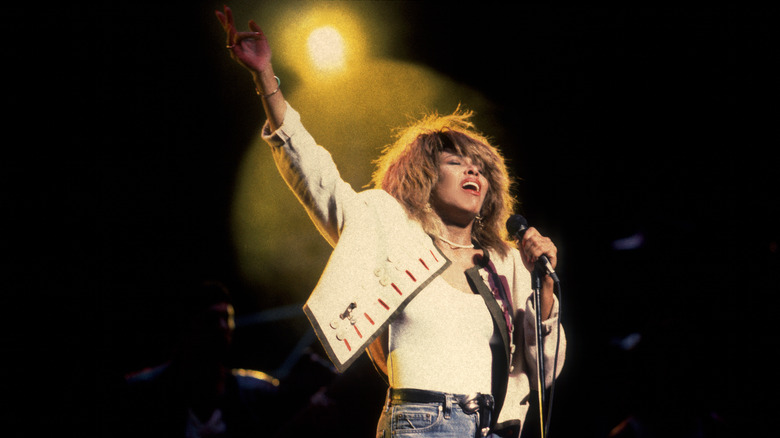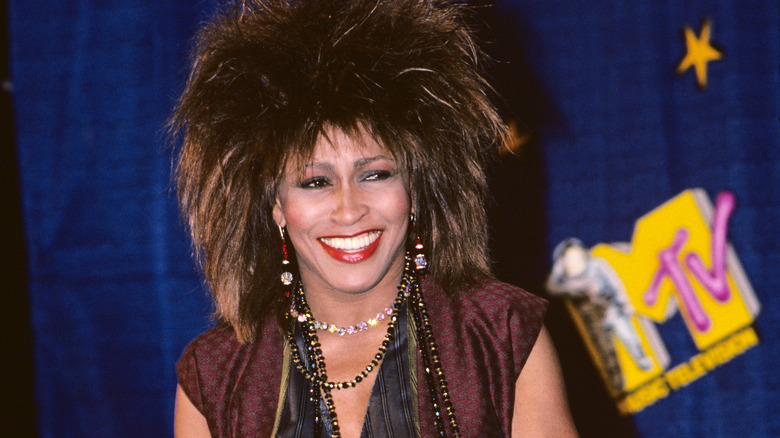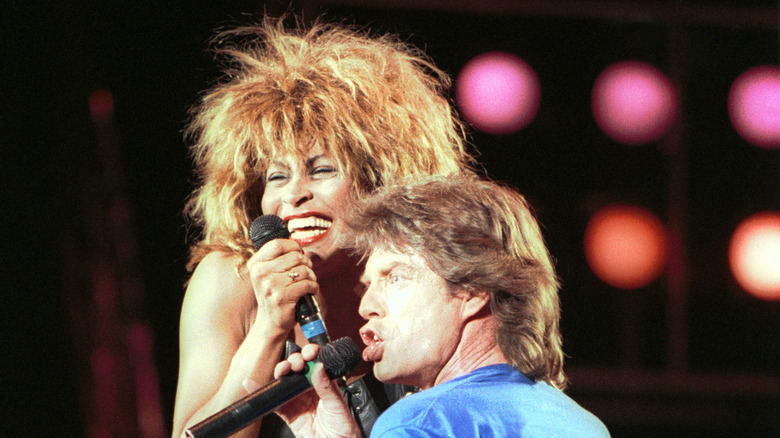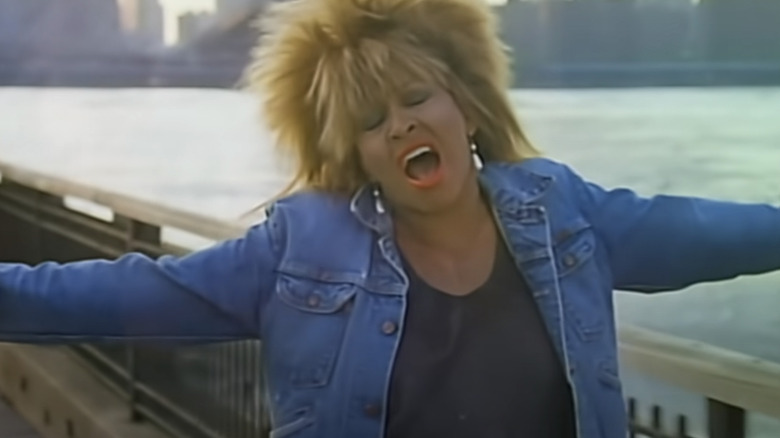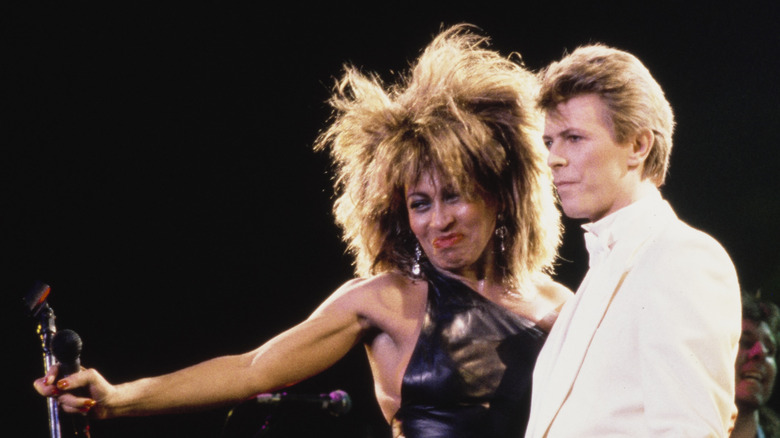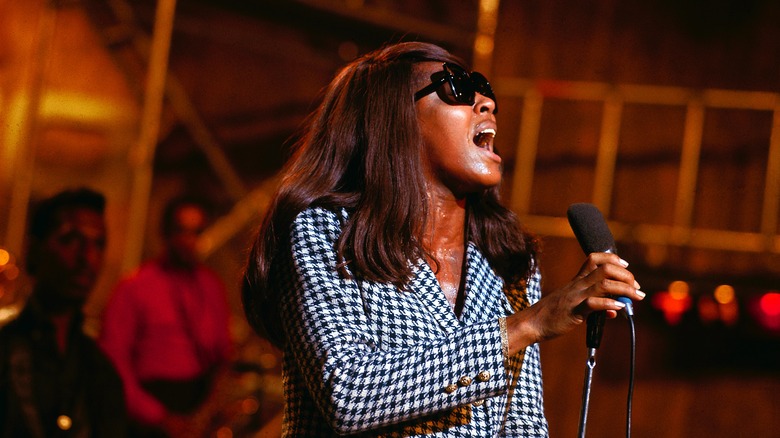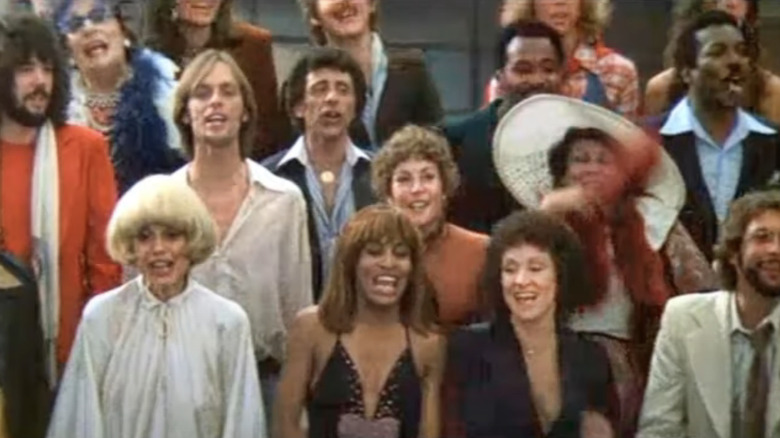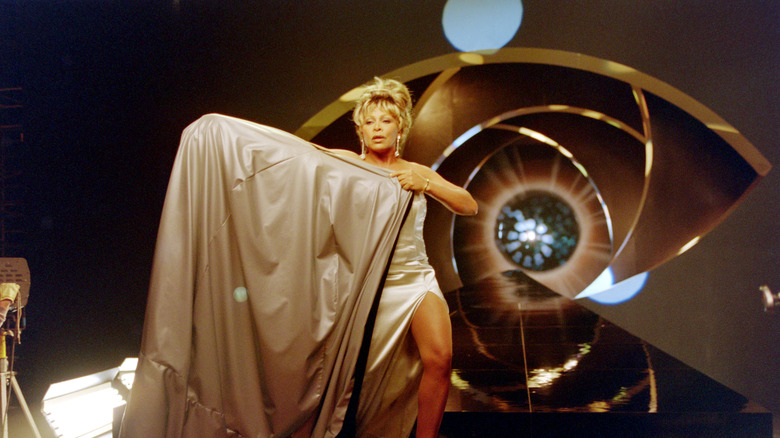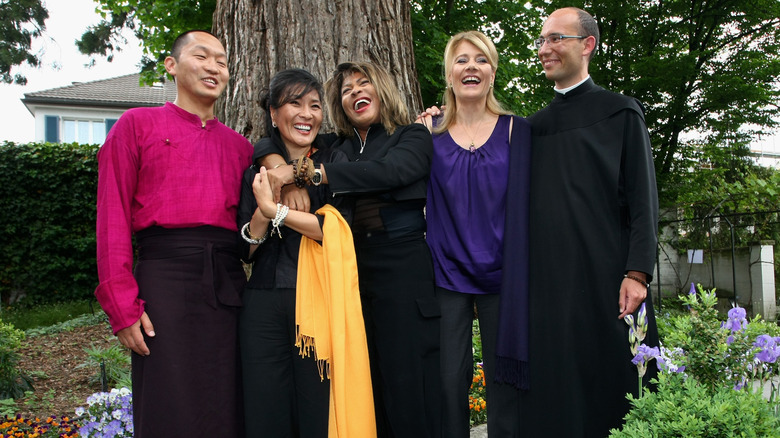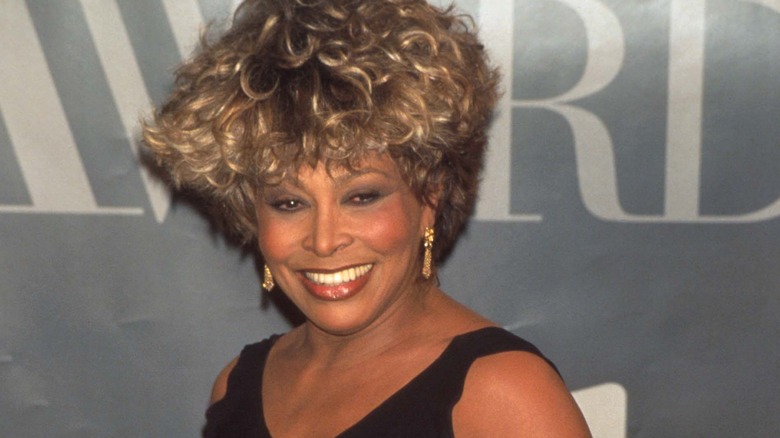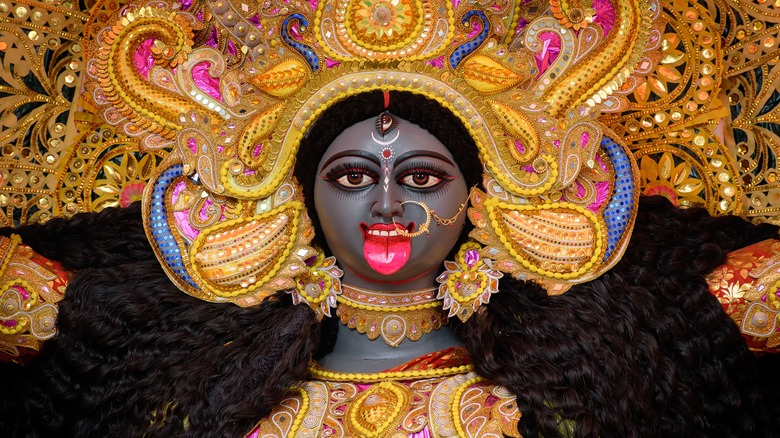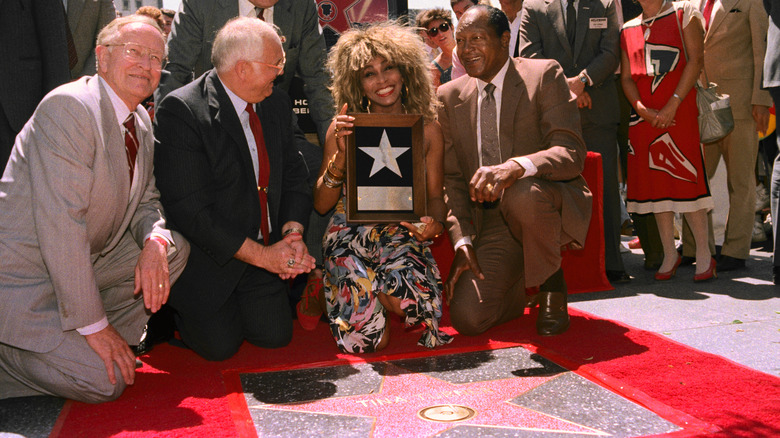Tina Turner Facts Only Her Biggest Fans Know
6/5/23 Correction: A previous version of this article stated that Tina Turner won two Grammys in 1984. She won them in 1985, not 1984.
Tina Turner was an icon of music, often known as the Queen of Rock and Roll. Famed for her powerful vocals and vivacious stage presence, she brought an infectious joy to her performances which is difficult to match. Like any true performer, it's clear from watching her concerts that she had an unbridled love of being on stage and singing to an audience. This passion was how she originally got her break into music. In an interview with Rolling Stone, she mentioned how she took the microphone while Ike Turner's band Kings of Rhythm was taking a break from performing, catching everyone's attention with her vocal talent.
Her career in music spanned over six decades, from singing with Kings of Rhythm in 1957, until 2020 when she came out of retirement to work with Norwegian producer DJ Kygo. In what would be her final foray into music, they were collaborating on a remix of her famous song, "What's Love Got To Do With It?" Her biggest ever hit, this was one of the songs from her album "Private Dancer" which, at the height of her career, went platinum in the U.S. five times. Living a brilliantly full life, while Tina Turner was no stranger to tragedy, she always pushed back, becoming one of the great names of the 20th century. Over her many eventful years, she accomplished many things, some of which may surprise all but the most ardent of her fans.
She was one of the first Black artists on MTV
Tina Turner's comeback in the 1980s has been described as one of the greatest in history, and one thing which likely helped her rise back to fame was MTV. After it started broadcasting in the early '80s, MTV brought a sudden demand for music videos, and Tina Turner was there just as they were starting to rise to prominence. But early MTV wasn't the diverse showcase we know today. An article by Jet, a magazine focusing on African-American culture, highlights criticism of the dearth of Black performers in the first days of MTV, quoting singer Rick James as mentioning in 1983 that Turner was the only Black artist MTV aired at the time.
With MTV playing her videos around the clock though, it no doubt helped her gain visibility, popularising her music with anyone watching the fledgling music channel. Together with Donna Summer, Turner's presence on MTV was an inspiration to Black Gen Xers. At the same time, her style appealed to fans of rock music, standing comfortably alongside big names like Mick Jagger and David Bowie. The result was a volcanic rise to stardom which saw her becoming a household name worldwide. Impressive, considering the fact that just a few years earlier, she'd been reduced to little more than a nostalgia act singing in hotel ballrooms.
She was an opening act for the Rolling Stones
While she was relaunching her singing career in 1981, Tina Turner joined the Rolling Stones for their American Tour. For each performance, Turner was the opening act, but she wasn't constrained to this role. A 1981 review by The New York Times mentions that she also joined the Stones on stage for their performance of "Honky Tonk Women." This was no doubt because she already knew the band well at the time. In particular, Mick Jagger was good friends with Turner, and he's been vocal about praising her talent as a performer, as well as her warm personality.
This was actually the second time Turner had toured with the Stones. Her autobiography, "I, Tina" mentions that she'd joined them when she was still performing with her ex-husband Ike, in their 1969 tour — the same year that Mick Jagger and Keith Richards wrote "Honky Tonk Women." Turner later mentioned that she also helped teach Jagger how to dance. With him being eager to learn and her being a dancer, it was a perfect match. Occasionally, the Stones were also joined on their 1969 Tour by Chuck Berry. Later on, he too would offer some help for Turner's comeback, featuring her in his 1982 TV special, performed at The Roxy in West Hollywood.
She didn't want to record her greatest hit
The song "What's Love Got To Do With It?" is one of Tina Turner's best known, ranked by Time Out at number 16 on their list of 60 best songs of the '80s. When she first heard it though, Turner didn't want to perform it. The song was offered to her by producer Terry Britten, together with another song, "Show Some Respect," but Turner felt they didn't fit her style. She described them as "wimpy" and disliked them so much that she refused to even listen to them — when her manager, Roger Davies, kept trying to play them to her, she'd run and hide. At the time, Turner had no idea the songs had been written specifically for her. Britten had to appeal to her personally to convince her to record them.
In the end, "What's Love Got To Do With It?" ended up being the song that cemented Turner's stardom. It would be her first and only No. 1 hit single, staying at the top spot of the charts for three weeks. With Turner's characteristic vocal style, the song became wildly popular. It ended up winning her two Grammies in 1985, for Record Of The Year and Best Female Pop Vocal Performance.
She recorded a duet with David Bowie
Tina Turner and David Bowie were close friends. The song "Tonight" was originally written by Iggy Pop, the godfather of punk, and first released as part of his 1977 album "Lust For Life." The song would later be picked up by Bowie, becoming the title track for his 1984 album "Tonight." The song was recorded as a duet with Turner but, strangely, when Bowie's version of the song was first released, it made no mention of Turner's involvement and didn't include a music video.
This probably wasn't intended as a snub though. Bowie was one of the artists to point out the lack of Black performers on MTV, and had long been a friend of Tina Turner's. He'd actually helped convince her record label to renew her contract in 1983. Female First recounts the story of how Bowie, who'd recently been re-signed by Capitol himself, was invited to a celebration dinner. He declined the invitation, saying "I'm sorry, but I'm going to the Ritz to see my favorite singer perform." The singer in question was Turner, and her strong performance that night was what convinced the Capitol executives to renew her record deal.
The two would later perform "Tonight" together on stage, during Tina Turner's 1985 Private Dancer tour. They'd occasionally perform it together again in later concerts through the '80s, showing their excellent chemistry together on stage. Turner later described Bowie, together with Mick Jagger, as being like the brothers she never had.
Her Rolling Stone cover appearance was historic
Tina Turner has been on the cover of Rolling Stone magazine several times over the decades, but her first appearance was in 1967. Shortly after Ike & Tina Turner had broken through into mainstream success, and at the height of the Civil Rights Movement, Tina being featured so prominently was historic. She was both the first woman and the first Black artist to appear on a Rolling Stone cover. The magazine would later rank her at No. 17 in their list of 100 greatest singers of all time.
Following her appearance on Rolling Stone, Turner would later be featured on a variety of other magazine covers, including several of the most important in music and pop culture. One of these was Ebony (an honor she shared with Nichelle Nichols), where she was lauded as the best-dressed woman of 1971. She'd later grace the covers of at least 137 different magazines, including Elle, NME, Good Times, Cosmopolitan, Time Out, and Jet. In 2013, at the age of 73, she became the oldest woman to appear on the cover of Vogue.
She had a brief cameo in a terrible Beatles movie
The jukebox comedy movie, "Sgt. Pepper's Lonely Hearts Club Band" is widely recognized as being completely awful. Unlike movies like "Yellow Submarine," this was not created by the Beatles themselves. Instead, it was based on an off-Broadway musical, "Sgt. Pepper's Lonely Hearts Club Band on the Road," which also had little association with the band other than using their music. The movie version flopped hard, with Time panning it as "contagious vulgarity" in a review that completely tore it to shreds. The Beatles themselves reportedly hated it, with Paul and Ringo disowning it after attending the premier, while John and George refused to watch it at all.
The movie was notable, however, for casting a variety of big-name musicians to play roles, including The Bee Gees (who tried to back out two weeks after the movie went into production). The ending features an ensemble singing a reprisal of the main Sgt. Pepper's theme tune, referred to as "Our Guests at Heartland." Among the many vocalists singing is Tina Turner, who can be seen standing at the front of the group.
She nearly didn't sing Goldeneye
The James Bond movies have been running since 1962, but the early '90s saw a six-year hiatus between movies. When "Goldeneye" was released, it was into a different world where the Soviet Union no longer existed, in which some considered the titular main character outdated. Promoted as a grand return for James Bond, a good title song was essential. Tina Turner's rendition of the "Goldeneye" theme, with her characteristic powerful, gravelly vocals perfectly hit the mark. But when she first heard the song, Turner didn't want to sing it.
Written by Bono and The Edge from U2, it was originally intended to be sung by Depeche Mode but, according to The Independent, they were too busy to record it at the time. Bono then put together a demo and sent it to Tina Turner, who promptly rejected it. While she was a fan of U2, the demo was so bad that Turner felt as if they'd expected her to turn down the song. She said later on that she hadn't even known what key she was supposed to sing it in! Bono had to personally ask her to perform it, ultimately being impressed by the version Turner came up with. While ultimately, the movie "Goldeneye" was among the less memorable from the James Bond catalog, Tina Turner's theme song for it has been celebrated as among the best Bond themes.
She recorded spiritual music
While she had a Christian upbringing, Tina Turner began to adopt Buddhist beliefs in the 1980s. Rather than fully converting, she chose to weave together the two backgrounds. Per Rolling Stone, she described herself as a "Buddhist-Baptist," drawing on her Buddhist beliefs to write the book "Happiness Becomes You," offering wisdom on how to find peace. She previously noted how this helped improve her own worldview, saying how "Buddhism changed my old thought patterns. It taught me to be a positive thinker."
As a singer, her choice to get involved in spiritual music made perfect sense, especially as a return to her roots singing in church. In 2009, she started working with Regula Curti and Swiss-Tibetan singer Dechen Shak-Dagsay, forming a group called Beyond. Their first record, "Buddhist and Christian Prayers" had words written by Turner herself. Deeply personal, they're based on a mixture of holy texts and poems from the famous Persian poet Rumi, with music inspired by both Christian hymns and Buddhist chants. While Tina Turner's most famous songs may be powerful rock ballads, Beyond allowed her to show a different side to her personality and singing style. That said, it still includes a few references to her more famous stage persona, like the line, "What does love have to do with it?" Buddhism got Turner through some difficult parts of her life, and she's described herself as like "a lotus flower, blooming over and over again against all odds, emerging stronger each time."
Her most famous song wasn't written for her
Just saying the words "simply the best" is enough to make a lot of people think of Tina Turner's most iconic song. "The Best" is deeply embedded in pop culture and has been widely played (and parodied), often being adopted as an anthem at sporting events. But while Turner's version of the song may be the most famous, it wasn't the first. In an interview with Music Business Worldwide, songwriter Holly Knight explains that she originally intended it to be sung by British singer Paul Young. Young's agent declined the song though, and it was then given to Bonnie Tyler, famous for "Total Eclipse of the Heart" and "Holding Out for a Hero." Unfortunately, Tyler's version failed to take off. It wasn't until it fell into the hands of Tina Turner that it became the song we all now recognize. Combining her formidable vocals with a saxophone solo and a key change, her version of the song has been described as "flawless."
Holly Knight was amazed by the song's continued widespread fame, saying, "The Best was not written for Tina Turner, but it was meant for her." Bonnie Tyler has also applauded Turner's rendition of the song. When the popularity of her music began to wane towards the end of the '80s, she began to doubt herself. In an interview with Retro Pop, she credits Turner's success with "The Best" as helping her regain confidence in her song choices.
She almost played the Hindu goddess Kali
Tina Turner was no stranger to acting, and her most famous role was as Aunty Entity in "Mad Max: Beyond Thunderdome" in 1985. She brought her unique charm and charisma both to the role itself and to the movie set where she was working. Director George Miller has mentioned that Turner was the only person ever asked for the role. She was the perfect choice.
Another role Turner very nearly played was a literal goddess. In Hinduism, Kali is the goddess of power, destruction, and change. As The Telegraph of India explains, Turner was excited to play the role in 2004 when she was cast in a movie called "The Goddess." In preparation, she traveled to India and toured Hindu temples, particularly in Bengal which is famous for its Kali temples. She also learned about folk dance styles — the Dance of Destruction is a vital part of the story of Kali, in which she accidentally steps on her husband, the god Shiva. Unfortunately, the movie was shelved indefinitely after its director, Ismail Merchant, passed away.
Interestingly enough, there's also a link back to rock music in this role. Kali is very often portrayed sticking out her tongue, said to be an expression of her surprise at stepping on Shiva. This imagery of Kali directly inspired Mick Jagger to create The Rolling Stones' instantly recognizable lips-and-tongue logo. As a close friend of Jagger's, Turner would likely have been well aware of this fact.
She's celebrated on three walks of fame
Tina Turner was awarded a star on the Hollywood Walk of Fame in 1986, as her popularity was at an all-time high. Following her death, fans turned her Hollywood star into a memorial, leaving floral bouquets, some of them carrying her vinyl records in tribute. But Hollywood isn't the only Walk of Fame to recognize her impact. She also has a star on the St. Louis Walk of Fame, in honor of her long and prestigious musical career. The third such place to immortalize Turner is the European Walk of Fame in Rotterdam, The Netherlands. Instead of a star, the European site bears her handprints and signature in cement.
Walks of Fame aren't the only place to give Tina Turner multiple honors. She also has the distinction of being inducted into the Rock and Roll Hall of Fame twice! The first time wasn't under great circumstances. In 1991, per The New York Times, she was inducted together with her ex-husband Ike — a questionable decision in itself, compounded by the fact that Ike was incarcerated at the time for drug offenses. Tina herself declined to attend the ceremony. In 2021, she was finally inducted as a solo artist in her own right. As one of the artists who originally signed in support of the hall being built in Cleveland, it's heartening to know that they granted Tina Turner the award she truly deserved, as one of the world's greatest solo singers.
